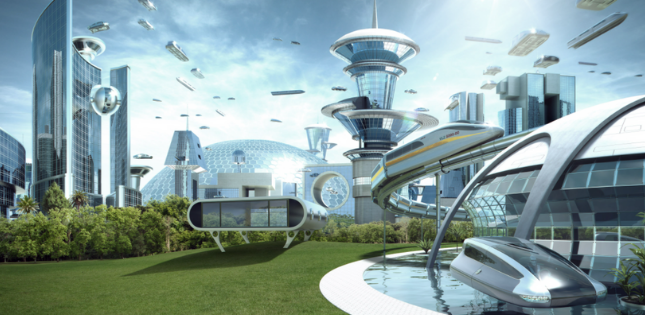
Come join me on a trip to the future. We won’t go far; only about 25 years from now. To get there, we simply orbit a nearby neutron star for a bit, and come back to Earth. Except for the face-stretching acceleration and extreme risk of death, time travel is like any other flight. Better, there’s no equivalent of jet lag; for us, time has simply not passed as much as for others. We’ll worry about how to get back later.
Today’s date is January 27, 2047. Our phones still says 2022. They don’t get service, but here’s a new device, a 9G roll-up called a Holophone. It’s connected to everything, including social media, technology and science, and current world, local, and business events.
The Holophone informs us that you have 9,125 unread daily news updates, and I have 8,442, nicely curated by the phone’s AI to reflect our interests. Scanning through them, ads abound, politicians rant, people post pets that need training and food that needs eating. The online world isn’t so different. Resisting the urge to binge-watch Squid Game season 19, we set off to see what’s new.
The Holophone has the new iCUs chip, capable of sustained 1.0 exaFLOPs. You wonder what it does with 100,000x more power than your old iPhone. Unrolling it, a see-through screen appears around you and augmented reality answers the question. Every building, every person, every plant, and every sound is labeled. “Blink-clicking” drills down, giving details from job profiles to maintenance status. Transparent information is everywhere, hopefully washing away the conspiracy theories we remember. Data really did turn out to be profound. Wondering what else has changed, we venture out onto the roadway.
Moving things are everywhere. Flying drones and transports dot the skies, surprisingly silent. Wheeled bags follow their owners down the sidewalk. eScooters, both with and without passengers, seamlessly merge into the mix. Larger transports, ranging from single-person pods to full-size buses, ply the roadways. Passengers are riders, not drivers. The few humans in control of these fleets serve functions other than driving, from helping people on and off to making decisions about where to go. There’s no traffic, no waiting, no honking, and no safety worries. The online world evolved a little. But the “offline” world is unrecognizable; no longer offline at all, it’s a coordinated, efficient, safe symphony. Everything is smart, and everything is connected.
Exploring more, we enter a hospital and find the staff interacting with patients and discussing treatments rather than running from room to room and documenting every action. In fact, they seem unharried. And the reason is obvious: the technology has truly joined their teams. Only a few years ago, staff visits were needed to ensure device operation, interpret readings and warning signs, and ensure constant monitoring. Even in intensive care, patients were only really checked every hour or so. Today, the instruments do that and more. The staff sets up instruments that self configure and connect together. Rather than once-per-hour visits, the machines monitor every patient 24x7, and integrate through AIs to improve alarms and recommend treatments. The biggest concerns of the past, like noticing patient deterioration, drug dosage changes, shift fatigue, and simple-but-dangerous mistakes, are gone. The machines handle the normal flow and recognize what’s not normal. The staffs’ job changed from full-time attention to critical clinical decisions and personalized care.
In the operating room, almost all surgeries are done with robotics. Robots come in all sorts of shapes: flexible tubes, snake-like arms, octopus-like grippers. Rather than mimicking human hands, they adapt human hands to fit into the nooks and crannies of patients with almost no incisions. They’re guided by following ever-more-precise and intelligent images and scans. Remote teams help surgeons learn and collaborate on hard procedures.
The doctors tell us that the 2020-21 pandemic was the real driver; staffing shortages, extreme frustration, and a new acceptance of remote care led to a new acceptance of automated help. The technology reduces staffing load and frustration, helps doctors collaborate, and makes better healthcare more accessible and affordable to all. The entire planet has better care.
We still wonder about defense technology and “killer robots”. After all, Skynet inspired a real need for time travel, remember Terminator? Has technology brought us closer to war?
Looking at our copious news-feed history answers some of that question. It seems full information reduces the temptation for the age-old spy-vs-spy subversion. Terrorism worries are lessened by long-dwell-time ocean surveillance drones. Better information on troop and equipment positioning helps calm international nerves. “Trust but verify” actually works when verify is possible.
Besides increasing international trust, potential mistakes are less likely. Defense systems now ensure positive target ID, establish clear intent, and enforce chain of command. There’s no Skynet-like robot command here. Instead of removing humans from the decision chain, intelligence reduces mistakes and keeps aggression in check. Global-scale realistic simulation makes training far better. Sure, all technology can be used for protection and destruction. But defensive strength and better information flow discourage conflict. Technology raises new threats for sure. But overall, the world is safer with each passing year.
And what of the environment? Climate change was a clear threat 25 years ago; have we made progress?
Transportation is certainly greener. Looking back at the street...there are few things with exhaust; EVs are the norm. Urban flight is also electric; adding advanced prop and thruster design accounts for the silence. Hyperloops speed across distances faster than airplanes with 100% solar energy. Since automated vehicles can leave the city when not needed, parking lots are being replaced by parks and better housing. Smart vehicles are not just safer and more efficient. They also take pollution out of the air and crowded lots out of the city.
A visit to the local power company confirms an even greater trend. Only a few years ago, the industry had no way to fully utilize unreliable wind and solar. The epiphany: the primary barriers to green energy are storage and distributed control rather than raw generation. Back in the 2020s, hydropower was already transitioning to a grid balancing function, filling in when renewables went offline and backing off when wind and sun were plentiful. Finally, this design is spreading to more types of generators and utility-scale storage technologies. With distributed control, we are making the dream of green energy viable! We were, unfortunately, too late to avoid all the carbon impact. But with continued progress, we are on a path to limit the worst of the global warming threat.
Looking around further, everything in general is running smarter. Back in the 2020s, the only real use of AI was in the cloud. Only 25 years later, it’s not just the Holophone that has processors that are 100,000 times better. Intelligence is now available to cars, traffic control, urban air mobility, trains, renewable energy, hospital devices, surgical robots, naval systems, air defense, avionics, simulation and training. By taking a step out of the cloud, AI is doing more than just slinging ads. It is making the entire planet run better.
So how did all this happen? We have a bit more time, so we ask as many system designers as we can: What changed? What was the hardest step to get here? They are clear on the answer: the primary blocker, surprisingly, was not the algorithms or processors. The key to progress, the realization that made all these smart systems practical, was the importance of data.
That doesn’t sound new, even to our ancient ears. Everyone knows that data makes AI work! Even 25 years ago, this was the mantra: collect the data and learn. This is how “digital twins” and consumer models work everywhere. But the view of data as static stuff that can be “collected” isn’t viable in the real world. Alphabet and Meta (remember the quainter names?) have days, months, years, or decades to figure out what ads to show us. Cars, planes, hospitals, and power systems have far less time to understand and react to the environment. These systems deal in milliseconds. And thus…the most profound realization of all:
Intelligence in the cloud needs data.
Intelligence in the real world needs data flow.
This simple truth is perhaps the most profound learning of our visit. Getting the right data to the right place at the right time enables real-time edge intelligence. To make the world run better, don’t design systems around algorithms, devices, or even functions. To make the world run better, design systems around the data flow.
Way back in the 2020s, there were a few forward-thinking companies that were leading the way, using the term “data centricity” and adopting middleware that organized the flow into intimately-shared information. It was just catching on. Our trip to the future showed that these visionaries successfully introduced their applications into many industries, transforming them all to be better. Now we know:
A smart world runs better. Real-time intelligence matters.
With that insight, it’s time to go back and spread the word! Let’s go! We ask the Holophone how, and discover a problem: time travel is one way. Through a clever use of entanglement, we did (will) sneak this trip report back; there is, after all, no fundamental science that says it’s impossible. Visionaries will just have to believe it.
Oh well, let’s just stay in the future. It’s not all that bad. Hey, isn’t that a Starbucks?
This vision of the future brought to you by RTI, the #1 framework for autonomy. Except for the Holophone, all applications described are (projections of) current RTI customer projects. RTI Runs a Smarter World™.
Top image source: www.gelmi.com.br
About the author
 Stan Schneider is CEO of Real-Time Innovations (RTI), the largest software framework provider for smart machine and real-world systems.
Stan Schneider is CEO of Real-Time Innovations (RTI), the largest software framework provider for smart machine and real-world systems.
Stan also serves on the advisory board for IoT Solutions World Congress and the boards of the Teleoperations Consortium and the Autonomous Vehicle Computing Consortium (AVCC). Stan holds a PhD in EE/CS from Stanford University.
Posts by Tag
- Developers/Engineer (177)
- Connext DDS Suite (77)
- Technology (74)
- News & Events (73)
- 2020 (54)
- Standards & Consortia (51)
- Aerospace & Defense (48)
- Automotive (35)
- 2023 (34)
- 2022 (29)
- IIoT (27)
- Leadership (24)
- 2024 (22)
- Cybersecurity (20)
- Healthcare (20)
- 2021 (19)
- Connectivity Technology (15)
- Military Avionics (15)
- Culture & Careers (14)
- FACE (13)
- Connext DDS Pro (10)
- JADC2 (10)
- ROS 2 (10)
- 2025 (7)
- Connext DDS Tools (7)
- Connext DDS Micro (6)
- Databus (6)
- Transportation (5)
- Case + Code (4)
- Connext DDS (4)
- Connext DDS Cert (4)
- Energy Systems (4)
- FACE Technical Standard (4)
- Oil & Gas (3)
- RTI Labs (3)
- Research (3)
- Robotics (3)
- #A&D (2)
- Connext Conference (2)
- Edge Computing (2)
- MDO (2)
- MS&T (2)
- TSN (2)
- ABMS (1)
- C4ISR (1)
- ISO 26262 (1)
- L3Harris (1)
- LabView (1)
- MathWorks (1)
- National Instruments (1)
- Simulation (1)
- Tech Talks (1)
- UAM (1)
- Videos (1)
- eVTOL (1)
 Success-Plan Services
Success-Plan Services Stan Schneider
Stan Schneider